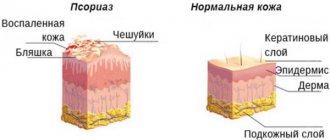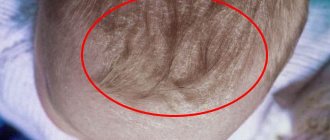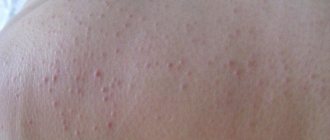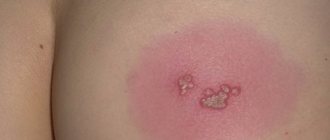Herpes on the leg: sores
Doctors identify two key reasons for the development of herpes on the leg:
- herpes types I and II;
- chickenpox virus (Varicella-Zoster).
The peculiarity of the second factor and the key difference from the first is the ability to cause severe pain of neurological origin, a rash throughout the patient’s body.
Neuralgia persists in the patient even when other signs are completely eliminated, and does not pass for several months or years.
Treatment methods for herpes on the legs depend on the specific virus that causes it. For accurate diagnosis it is necessary to use modern laboratory tests.
In more rare cases, rashes on the legs may appear due to the penetration of the virus through various skin lesions (abrasions, scratches).
This is possible, for example, for people involved in contact sports: rugby, wrestling, etc.
Herpes on the toes and other areas can occur in patients with immunodeficiency. In this case, the infection spreads throughout the body, rashes appear on the back, limbs, abdomen, etc.
This disease has severe generalized symptoms.
Herpes on the leg photo
How dangerous is it to have a herpetic infection on your feet?
In general, for a healthy person, the appearance of herpes on the leg is not dangerous. Its most severe symptoms in this case are, perhaps, pain at the site of the rash and a slight deterioration in general well-being. Including herpetic lesions of the legs of a child (not a newborn) does not pose any particular threat to his health and does not threaten dangerous consequences and complications.
Herpes is truly dangerous for patients with immunodeficiency, as well as for patients whose immunity is deliberately suppressed for the purpose of undergoing an organ transplant operation. If uncontrolled by the body's defenses, the virus can cause severe damage to internal organs:
- Hepatitis;
- Encephalitis and meningitis;
- Nephritis with further renal failure.
...And other complications.
Note: in AIDS patients, the leading cause of death is herpes viruses. As a rule, these are cytomegalovirus and Epstein-Barr virus when they are r?
Factors of herpes virus infection
According to medical statistics, more than 95% of the planet’s inhabitants are carriers of the virus. However, its transition to an open form is rare.
It is provoked by the following factors:
- weakened immunity due to acute or chronic diseases;
- frequent stress;
- violation of the daily routine, incorrectly selected diet;
- taking medications that suppress the immune system;
- infection with HIV, AIDS.
Once entering the human body, the strain of the disease remains in it forever, remaining in the elements of the nervous system.
He is only waiting for the right moment to move from a latent form to an open one.
How does herpes start in children?
In most cases, the symptoms of herpes in children are typical, which makes it possible to accurately identify the disease. In childhood, almost all children get chickenpox, one of the types of herpesvirus. Herpes in children (photo 2) begins with a feeling of discomfort on one of the parts of the body where the rash appears. The site of the future rash becomes painful and itchy. The herpes virus develops rapidly in children, just like in adults. At the site of discomfort, after a short period of time, pimples with transparent contents appear, painful to the touch.
Herpes develops in young children over several days, during which the rash matures, its contents become cloudy, and the surface is soon damaged and the contents come out. The manifestation of herpes in children may be accompanied by fever and signs of intoxication. During the healing stage, as a rule, the child’s condition improves significantly. After scarring, herpes in children looks like a healthy skin surface; usually no scars remain.
Herpes on the leg: symptoms and clinical picture
The symptoms of the disease depend on the type of pathogen. There are two main forms:
Herpes zoster on the leg
With this form, the rash is localized on one limb. They usually appear on the patient's side and then move to the outside of the thigh.
Externally, the rash resembles a belt tied around the leg.
It has a characteristic dark red color, with single bubbles scattered across the surface of the affected area.
Herpes on feet photo
Herpes simplex
The rash does not have a pronounced red tint; it can occur on both legs, spreading over their entire area, and not just on the thigh.
The problem may be present on both limbs. The rashes do not occupy a large area; usually their surface is easy to cover with the palm of your hand.
Experts distinguish between a genital type of virus. The rash appears on the genitals and groin area and can then spread to the inner thigh.
Another form of the disease is herpes on the foot. It is less common, simple and shingles, and is represented by single vesicles on the fingertips.
Usually the problem is localized on one finger.
With herpes on the leg of any type, a slight increase in the patient’s body temperature (up to 37.5 degrees) is possible. Other signs may be completely absent.
Other manifestations given by the body as a reaction to the disease are headaches, nausea, vomiting, poor quality of sleep, general depression and loss of strength.
Herpes on the feet photo
Causes
Let's get acquainted with the causes of herpes on the thigh. The most common is household contact with a carrier of this virus. What could it be? Close, sexual contact with someone suffering from herpes on the inner thigh.
Also, genital herpes can “spread” to the thigh if the patient does not take good care of the emerging ulcers: you need to carefully treat not only the vesicle itself, but also the areas around it with a solution.
How does the disease develop?
The transition of the virus from latent to open form has the following chronology:
- At the future site of localization of herpes simplex (or herpes zoster), mild pain and itching appears. This occurs several hours (days) before the onset of the main symptoms.
- Over the next day, papules form on the patient's legs - blisters that rise above the surface of the skin. Gradually their number reaches a maximum.
- On the third day, the affected areas become covered with ulcers - traces of ruptured papules. These places become covered with crusts.
- After another 4-5 days, the crusts disappear, and no traces of the disease remain on the patient’s legs.
This is the clinical picture of herpes on the leg of a simple and shingles type.
In the disseminated form of the disease, rashes and blisters cover different parts of the body, not just the skin of the extremities.
The disease harms all systems and organs of the patient, and if left untreated can be fatal.
Symptoms
The main symptom of herpes is a rash that looks like blisters filled with clear or cloudy liquid. Initially, the skin begins to turn red, swelling, itching and burning appear. Then bubbles 1-2 mm in size form on the surface. They are located in groups, forming large areas of rash. After a few days, the blisters burst and fresh skin appears in their place.
Most often, the rash occurs on the soles of the feet, toes, and thighs. Less commonly, other areas of the extremities are affected.
Additionally, symptoms of herpes may appear, such as fever, nausea leading to vomiting, headaches, loss of appetite, insomnia, general malaise and weakness. Herpes type 3 develops in areas of affected nerve cells in the body, which causes severe neuralgic pain. During primary infection, a person suffers from chickenpox. In case of relapse, herpes zoster develops.
How to distinguish a case of herpes virus infection from other skin diseases?
Other skin diseases are often mistaken for herpes due to the similarity of symptoms. For example:
- Allergic reactions - rashes can closely resemble herpes, and diagnosis is difficult. It is important to pay attention to the behavior of the blisters: in case of allergies, they do not burst or crust over, and spread over all the legs.
- Fungal infections, dermatitis - redness occurs, the affected areas become covered with a rash, but these problems last much longer than in the case of a viral disease.
- Shingles differs from the virus in its special localization: on the outer side of the thigh, most often on one leg.
If a skin problem does not go away for more than two weeks, it is not herpetic in nature.
Herpes on a child's legs photo
Possible complications
In most cases, herpes can be successfully treated and does not cause serious harm to health. If the immune system is suppressed, post-herpetic complications are possible. Diseases that can develop against the background of the virus:
- meningitis, encephalitis;
- pneumonia;
- inflammation of internal organs (liver, kidneys, gastrointestinal tract, etc.);
- herpetic arthritis;
- disruption of the cardiovascular system;
- damage to the reproductive system and urinary organs;
- conjunctivitis.
Neuralgia is often a consequence of herpes zoster. It manifests itself in the form of severe pain and itching in the affected area. Antiviral drugs are ineffective to eliminate the problem. In this case, antidepressants, painkillers, some types of physiotherapy and vitamins are prescribed.
Treatment of herpes
Therapy is usually carried out comprehensively, which reduces the duration of the disease. The patient is shown rest and bed rest.
It is recommended to change bedding and towels frequently to prevent the infection from spreading to other parts of the body.
Reddened areas of the skin should be lubricated with brilliant green and furatsilin.
Effective treatment of herpes is impossible without the prescription of antiviral drugs, for example, acyclovir, valacyclovir and others.
The decision on the choice of medication is made by the doctor, having determined the specific causative virus.
Creams and ointments prescribed by a specialist should be applied to areas of skin with rashes up to five times a day.
If the disease causes severe pain, the patient is prescribed painkillers and (or) non-steroidal anti-inflammatory drugs.
To generally increase the body's defenses, allowing you to quickly overcome the virus, it is recommended to take multivitamins and (or) immunomodulators.
Do not try to eliminate herpes on your leg yourself. Consult a doctor who will determine the cause of the disease and prescribe effective treatment.
Otherwise, the disease can lead to serious complications.
Virus prevention
There are many ways to prevent a viral disease. Among them:
- Herpes vaccine - Zoster. An effective drug, but with a large number of contraindications. It should not be administered during pregnancy, allergies, or acute respiratory viral infections.
- Taking immunomodulators. To prescribe them, you must consult an immunologist. You will also need to take tests and undergo a general examination.
The simplest and most effective method of prevention is taking care of your health and strengthening your immune system. To do this, it is enough to eat properly and nutritiously, get rid of bad habits, and exercise regularly.
[youtube.player]









